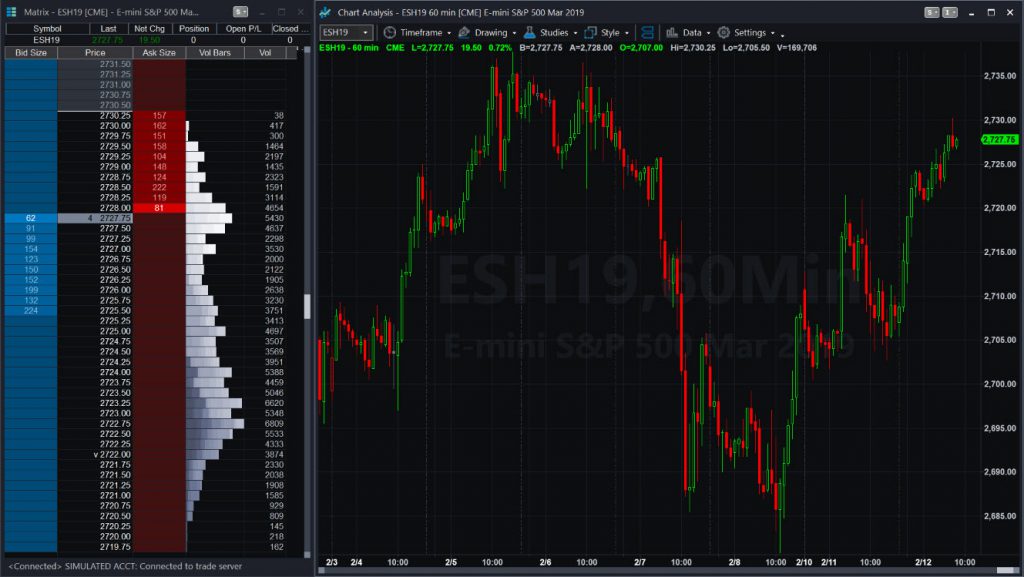You’ve probably heard of about “stock market futures,” but do you really know what they are? Today let’s start by looking at the most popular item in the market: CME’s S&P 500 E-minis.
These contracts track the most widely followed stock benchmark in the world. Every point up or down by the S&P 500 index translates into $50 of value change for each contract in a client’s account. They’re available 23 hours a day, from Sunday night through Friday afternoon.
While E-minis track the stock market, they behave very distinctly from shares because they’re futures. The most important difference is that you don’t see a value for each contract in your account. If, for example, you owned 100 shares of $20 stock, your account would be worth $2,000.
Stocks vs. Futures
With futures, however, you start with a certain amount of principal and then make or lose money according to the market. If you buy one E-minis contract for 2700 and sell it for 2710, your contract will simply grow by $500. (Remember, each point represents $50.)
The next big difference is the fact that contracts change, or “roll,” periodically. E-Minis always start with the root “ES”, followed by an expiration month and year. Right now everyone’s focused on the March contract: “ESH19”. Next month we’ll flip to June, “ESM19.” (Each month has a letter code. It’s not an abbreviation.) September follows because E-minis have a quarterly roll.
Because the symbols change (unlike stocks), TradeStation provides “continuous contracts” so you can chart and analyze prices over a long period of time. So going forward you’ll see the S&P 500 E-minis referenced simply as @ES. Remember these are for historical purposes only and cannot be traded. If you want to take a real position you must use a specific contract.

The third big concept is margin, especially because this is different from margin in a stock account. With futures, margin is the capital required to take or hold a position. There are a few nuances:
- Initial margin is the amount of cash you need enter a long or short position on @ES. It’s currently $6,600 per contract.
- Maintenance margin, currently $6,000 per contact, is the amount of capital you need to hold a position. This is different from the initial margin because it shows how much of a loss you can take if a trade goes against you.
- Here comes the good news: These requirements are slashed by 75 percent for day traders between the normal market hours of 9:30 a.m. ET and 4 p.m. ET. That means you only need initial margin of $1,650 to go long or short a single contract and $1,500 of maintenance — as long as you exit your trade by the closing bell. (That’s 25 percent of the $6,600 initial margin and 25 percent of the maintenance margin, respectively.)
So with all these complications you might wonder, why even bother to trade @ES? There are several reasons.
Why Consider E-Minis?
First, they’re quite simple once you understand the differences from stocks. Secondly, @ES is extremely versatile for hedging. Say you have a large portfolio or market-tracking mutual fund, and are worried about a crash. Simply shorting a certain number of @ES contracts can offset losses as the S&P 500 moves lower.
Next, futures lend themselves to advanced charting and automated trading strategies — TradeStation’s bread and butter. Finally, there are often tax benefits to futures over stocks and exchange-traded funds.
In conclusion, CME’s S&P 500 E-mini contracts are the biggest show in town. Here’s a review of the basics:
- What it tracks: S&P 500 stock index
- How it tracks it: $50 per point, per contract, up or down.
- When it trades: Sunday at 6 p.m. ET through Friday at 5 p.m. ET. Each day during the week it halts 4:15-4:30 p.m. ET and 5-6 p.m. ET.
- Capital required during the normal session: $1,650 to enter, $1,500 to hold. (Subject to change.) This is based on the $6,600 initial margin requirement and the $6,000 maintenance margin.
- Expirations: Third Friday of March, June, September, December.
Next week we’ll look at another heavily traded product: Nymex Crude Oil (@CL).























